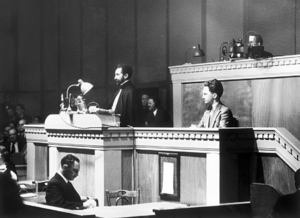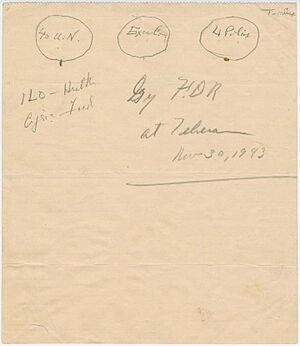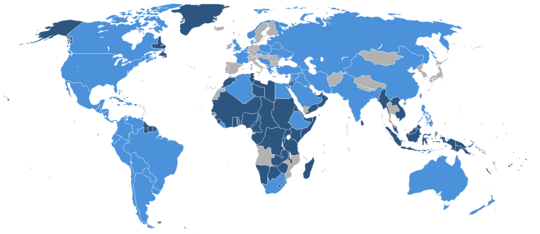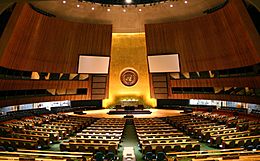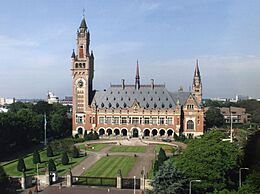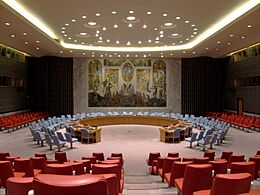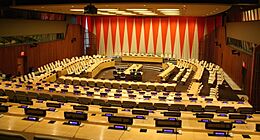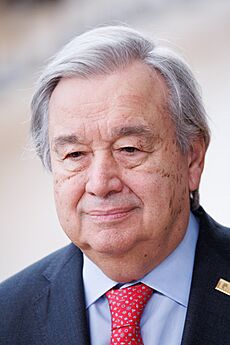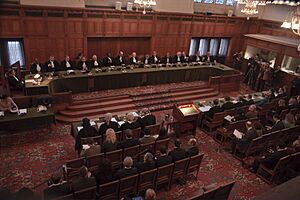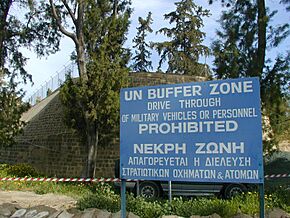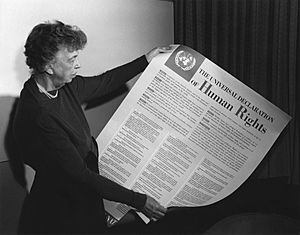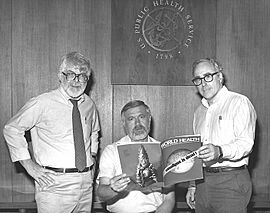United Nations facts for kids
Quick facts for kids
|
|||||||
|---|---|---|---|---|---|---|---|
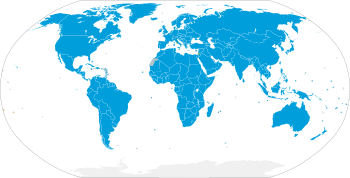
|
|||||||
| Headquarters | 760 United Nations Plaza, Manhattan, New York City (international zone) | ||||||
| Official languages | |||||||
|
Official script
|
|
||||||
| Type | Intergovernmental organization | ||||||
| Membership | 193 member states 2 observer states |
||||||
| Leaders | |||||||
| António Guterres | |||||||
|
• Deputy Secretary-General
|
Amina J. Mohammed | ||||||
| Philemon Yang | |||||||
| Establishment | |||||||
|
• UN Charter signed
|
26 June 1945 | ||||||
|
• Charter entered into force
|
24 October 1945 | ||||||
|
|||||||
The United Nations (UN) is a big international group of countries. It was started on October 24, 1945. Its main goals are to keep peace around the world and help countries work together. The UN also wants to build friendly relationships between nations. It helps solve global problems and makes sure countries act together to reach these goals.
The main office of the UN is in New York City. There are also other offices in places like Geneva, Nairobi, and Vienna. The UN has six main parts: the General Assembly, the Security Council, the Economic and Social Council, the International Court of Justice, the Secretariat, and the Trusteeship Council. These parts, along with other special groups, form the United Nations System. Today, 193 countries are members of the UN. There are also 2 observer states.
The UN has done a lot of work on helping countries grow and develop. This was especially true when many countries gained independence in the mid-1900s. Many people praise the UN for its work in peace and helping people. Some of its officers and groups have even won the Nobel Peace Prize. However, some people have also criticized the UN for not always being effective or for having problems.
Contents
How the UN Started
Before the UN: The League of Nations
Before the UN, there were other groups like the International Committee of the Red Cross. These groups helped people affected by wars.
After World War I, leaders like U.S. President Woodrow Wilson wanted a world group to keep peace. So, the League of Nations was created in 1920. It had 42 countries at first. The League Council helped run things. It started with four main members: the United Kingdom, France, Italy, and Japan.
The League had some successes in the 1920s. But in the 1930s, it struggled. For example, it could not stop Japan from invading Manchuria in 1933. Japan just left the League instead. It also failed to stop Italy from invading Ethiopia in 1936. More countries left the League.
When World War II began in 1939, the League of Nations basically stopped working.
Planning the United Nations (1941–1944)
The idea for the United Nations began during World War II. In 1941, leaders like U.S. President Franklin D. Roosevelt and British Prime Minister Winston Churchill wrote the Atlantic Charter. This paper set goals for the world after the war.
President Roosevelt came up with the name "United Nations" for the countries fighting against the Axis powers. Churchill liked the name. On January 1, 1942, Roosevelt, Churchill, and leaders from the Soviet Union and China signed the "Declaration by United Nations". Many other countries signed it too. During the war, "United Nations" became the official name for the Allies.
In 1943, the main Allied countries (the U.S., Soviet Union, UK, and China) met. They agreed to create a new international group. This group would replace the League of Nations. More talks happened in 1944 and 1945 to plan how this new organization would work.
Creating the UN (1945)
By March 1945, 21 more countries had signed the Declaration by the United Nations. On April 25, 1945, the UN Conference started in San Francisco. Fifty countries and many other groups attended. They worked for two months to write the Charter of the United Nations.
The Charter was signed on June 26, 1945, by 50 countries. The UN officially began on October 24, 1945. This happened when the five main members of the United Nations Security Council (U.S., UK, France, Soviet Union, China) and most other countries approved the Charter.
The first meetings of the General Assembly and the Security Council were in London in January 1946. They started discussing important world issues right away. New York City was chosen as the UN's headquarters. Construction began in 1948 and finished in 1952. Trygve Lie from Norway became the first UN Secretary-General.
The UN During the Cold War (1947–1991)

The UN's main job was to keep peace. But during the Cold War, the U.S. and the Soviet Union often disagreed. This made it hard for the UN to act in many conflicts. One big exception was in 1950. The Security Council allowed a U.S.-led group to stop North Korea from invading South Korea.
In 1947, the UN suggested dividing Palestine into two states. This plan did not work, and a war started. Later, a UN official helped arrange a ceasefire. In 1956, the first UN peacekeeping force was sent to end the Suez Crisis.
In 1960, the UN sent a large military force to the Democratic Republic of the Congo to help bring order. During this mission, Dag Hammarskjöld, a respected Secretary-General, died in a plane crash. He was given the Nobel Peace Prize after his death.
Many new countries joined the UN in the 1960s as they gained independence. In 1971, the People's Republic of China took China's seat on the Security Council. This showed that American influence in the UN was changing.
As the Cold War continued, the UN focused more on helping countries develop and on cultural exchange. By the 1970s, the UN spent much more on social and economic development than on peacekeeping.
The UN After the Cold War (1991–Present)
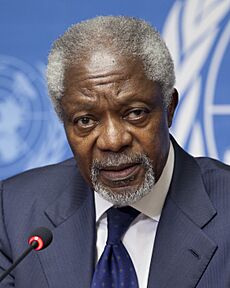
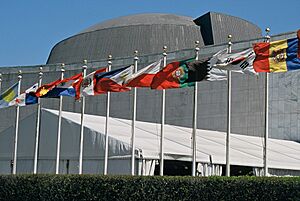
After the Cold War ended, the UN's peacekeeping work grew a lot. It took on more missions in five years than in the previous forty years. The UN helped end the Salvadoran Civil War and oversaw elections in South Africa and Cambodia. In 1991, the UN allowed a U.S.-led group to push Iraq out of Kuwait.
However, the UN also faced challenges. Some people criticized it for problems with management. In the 1990s, the UN struggled with crises in Somalia, Haiti, and Yugoslavia. For example, the UN mission in Somalia was not seen as successful. The UN also failed to stop the Rwandan genocide in 1994.
From the late 1990s, the UN's actions became more varied. It authorized NATO-led forces in Kosovo in 1999. In 2003, the U.S. invaded Iraq without a UN Security Council resolution. This led to more questions about how effective the UN was.
Under Secretary-General Ban Ki-moon, the UN sent peacekeepers to conflicts in Sudan and Congo. It also sent observers to the Syrian Civil War. In 2010, the UN lost many staff members in the 2010 Haiti earthquake.
In 2000, world leaders met at the Millennium Summit. They agreed on the Millennium Development Goals (MDGs). These goals aimed to reduce poverty, improve health, and promote equality by 2015. In 2015, the Sustainable Development Goals (SDGs) were launched to continue this work.
The UN has also tried to be more open and work with regular people. In 2016, it held its first public debate for Secretary-General candidates. On January 1, 2017, António Guterres became the ninth Secretary-General. He wants to focus on preventing conflicts and making peacekeeping better.
In 2025, the UN faced money problems because some member countries were late paying their dues. This caused budget cuts and affected the UN's work.
How the UN is Organized
The UN is part of a larger system with many different groups. It has five main parts, called "organs," set up by the UN Charter. These are the General Assembly, the Security Council, the Economic and Social Council, the International Court of Justice, and the UN Secretariat. A sixth organ, the Trusteeship Council, stopped working in 1994.
Four of the five main organs are in New York City. The International Court of Justice is in The Hague, Netherlands. Other UN offices are in Geneva, Vienna, and Nairobi. The UN has six official languages: Arabic, Chinese, English, French, Russian, and Spanish.
| UN General Assembly — Deliberative assembly of all UN member states — |
UN Secretariat — Administrative organ of the UN — |
International Court of Justice — Universal court for international law — |
||||
|
|
|
||||
| UN Security Council — For international security issues — |
UN Economic and Social Council — For global economic and social affairs — |
UN Trusteeship Council — For administering trust territories (currently inactive) — |
||||
|
|
|
||||
General Assembly
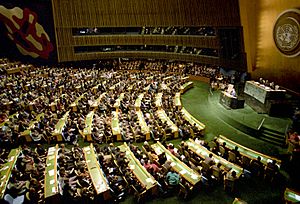
The General Assembly is where all 193 UN member countries meet to talk and make decisions. They meet every year in the General Assembly Hall. Special meetings can also be called. A president, chosen by member countries, leads the assembly. The first meeting was in London in 1946 with 51 countries.
For big decisions like peace, security, or new members, two-thirds of the countries present must agree. For other issues, a simple majority is enough. Each country gets one vote. The General Assembly's decisions are usually recommendations, not strict rules, except for budget matters.
The General Assembly gets ideas for decisions from its six main committees:
- First Committee (Disarmament and International Security)
- Second Committee (Economic and Financial)
- Third Committee (Social, Humanitarian, and Cultural)
- Fourth Committee (Special Political and Decolonization)
- Fifth Committee (Administrative and Budgetary)
- Sixth Committee (Legal)
Security Council
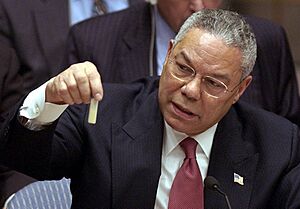
The Security Council's job is to keep peace and safety among countries. Unlike other UN parts, the Security Council can make decisions that all member countries must follow. These decisions are called United Nations Security Council resolutions.
The Security Council has fifteen member countries. Five of them are permanent members: China, France, Russia, the United Kingdom, and the United States. These five have "veto power," meaning they can block any resolution. The other ten members are temporary. They are chosen for two-year terms by the General Assembly. The country leading the Security Council changes every month.
UN Secretariat
The UN Secretariat handles the daily work of the UN. It has thousands of staff members from all over the world. The Secretary-General leads it, helped by a deputy. The Secretariat helps UN groups with their meetings and carries out tasks given by the Security Council and General Assembly.
The Secretary-General is the main spokesperson and leader of the UN. This person is the chief manager of the organization. The Secretary-General can also bring important issues about peace and security to the Security Council's attention. This role has grown to include being a diplomat and helping solve problems between countries.
The General Assembly chooses the Secretary-General, based on a recommendation from the Security Council. The permanent members of the Security Council can veto candidates. Usually, a Secretary-General serves for one or two five-year terms. The current Secretary-General is António Guterres from Portugal. He started in 2017.
| No. | Name | Country of origin | Took office | Left office | Notes |
|---|---|---|---|---|---|
| – | Gladwyn Jebb | 24 October 1945 | 2 February 1946 | Served as acting Secretary-General until Lie's election | |
| 1 | Trygve Lie | 2 February 1946 | 10 November 1952 | Resigned | |
| 2 | Dag Hammarskjöld | 10 April 1953 | 18 September 1961 | Died in office | |
| 3 | U Thant | 30 November 1961 | 31 December 1971 | First non-European to hold office | |
| 4 | Kurt Waldheim | 1 January 1972 | 31 December 1981 | ||
| 5 | Javier Pérez de Cuéllar | 1 January 1982 | 31 December 1991 | ||
| 6 | Boutros Boutros-Ghali | 1 January 1992 | 31 December 1996 | Served for the shortest time | |
| 7 | Kofi Annan | 1 January 1997 | 31 December 2006 | ||
| 8 | Ban Ki-moon | 1 January 2007 | 31 December 2016 | ||
| 9 | António Guterres | 1 January 2017 | Incumbent |
International Court of Justice
The International Court of Justice (ICJ) is the main court of the UN. It is also called the World Court. It helps solve disagreements between countries. For example, it has heard cases about war crimes. The court can also give advice on international law to other UN groups. All UN member countries agree to follow the ICJ's rules. Its decisions are binding for the countries involved. The court has 15 judges, each from a different country. They are chosen for nine-year terms.
Economic and Social Council
The Economic and Social Council (ECOSOC) helps the General Assembly with global economic and social issues. It is the UN's main place for discussing these topics. ECOSOC collects information, does studies, and gives advice to member countries. Its work is done by many smaller groups that focus on different topics. These include groups for indigenous peoples, forests, and sustainable development. ECOSOC can also work with non-governmental organizations (NGOs). As of April 2021, almost 5,600 organizations had this status.
Specialized Agencies
The UN Charter says that each main UN part can create special agencies to help with its duties. These specialized agencies work with the UN but are independent. They are connected to the UN system through agreements. There are fifteen specialized agencies. They do many different things, like helping with international travel, preventing diseases, and promoting economic growth.
| No. | Acronym | Agency | Headquarters | Head | Established |
|---|---|---|---|---|---|
| 1 | FAO | Food and Agriculture Organization | 1945 | ||
| 2 | ICAO | International Civil Aviation Organization | 1947 | ||
| 3 | IFAD | International Fund for Agricultural Development | 1977 | ||
| 4 | ILO | International Labour Organization | 1946 (1919) | ||
| 5 | IMO | International Maritime Organization | 1948 | ||
| 6 | IMF | International Monetary Fund | 1945 (1944) | ||
| 7 | ITU | International Telecommunication Union | 1947 (1865) | ||
| 8 | UNESCO | United Nations Educational, Scientific and Cultural Organization | 1945 | ||
| 9 | UNIDO | United Nations Industrial Development Organization | 1967 | ||
| 10 | UNWTO | World Tourism Organization | 1974 | ||
| 11 | UPU | Universal Postal Union | 1947 (1874) | ||
| 12 | WBG | World Bank Group | 1945 (1944) | ||
| 13 | WHO | World Health Organization | 1948 | ||
| 14 | WIPO | World Intellectual Property Organization | 1974 | ||
| 15 | WMO | World Meteorological Organization | 1950 (1873) |
Funds, Programmes, and Other Bodies
The UN system also includes many other independent groups. These include funds, programmes, and research centers. Each has its own work, leaders, and budget. For example, the World Trade Organization (WTO) and the International Atomic Energy Agency (IAEA) work closely with the UN. The UN does much of its humanitarian work through these groups. This includes preventing hunger (the World Food Programme) and helping refugees (the UNHCR).
| Acronyms | Agency | Headquarters | Head | Established |
|---|---|---|---|---|
| UNDP | United Nations Development Programme | 1965 | ||
| UNICEF | United Nations Children's Fund | 1946 | ||
| UNCDF | United Nations Capital Development Fund | 1966 | ||
| WFP | World Food Programme | 1963 | ||
| UNEP | United Nations Environment Programme | 1972 | ||
| UNFPA | United Nations Population Fund | 1969 | ||
| UN-HABITAT | United Nations Human Settlements Programme | 1978 | ||
| UNV | United Nations Volunteers | 1978 |
Who Can Join the UN?

Almost all independent countries in the world are members of the United Nations. South Sudan joined on July 14, 2011, making it the newest member. The UN Charter explains who can join:
- Any peace-loving country that agrees to follow the rules in the UN Charter can become a member. The UN must decide if the country is able and willing to follow these rules.
- The General Assembly decides to let a country join after the Security Council recommends it. Chapter II, Article 4.

Besides full members, there are two non-member observer states: the Holy See and Palestine. The Cook Islands and Niue are also connected to the UN through some of its special agencies.
Indonesia was the only country that tried to leave the UN. This happened in 1965 because of a disagreement with Malaysia. Indonesia rejoined the UN in 1966.
Group of 77
The Group of 77 (G77) is a group of developing nations within the UN. It helps these countries work together to improve their economies. It also gives them a stronger voice in UN discussions. Seventy-seven countries started the group in 1964. By November 2013, it had grown to 133 member countries. The G77 held its first big meeting in Algiers in 1967.
What the UN Aims to Do
The main plan for the United Nations is found in the United Nations Common Agenda.
Keeping Peace and Security
The UN sends peacekeepers to areas where fighting has stopped or slowed down. These peacekeepers, often called "Blue Helmets," wear blue helmets. Their job is to make sure peace agreements are followed and to prevent fighting from starting again. The UN does not have its own army. Countries volunteer their soldiers for peacekeeping missions. In 1988, UN peacekeeping forces won the Nobel Peace Prize.
Since 1947, the UN has done 71 peacekeeping operations. As of April 2021, over 88,000 peacekeepers from 121 countries were on missions. The longest mission, the United Nations Truce Supervision Organization (UNTSO), has been in the Middle East since 1948.
Studies have shown that the UN is often successful in its peacekeeping efforts. A 2005 study found that UN efforts led to lasting peace in two-thirds of cases. Other studies also found that UN peacekeeping helps reduce civilian deaths. The UN has also worked to reduce weapons. It has been involved in treaties about nuclear weapons and chemical weapons.
However, the UN has also been criticized for not always acting effectively. Sometimes, member countries do not agree on military action. This led to failures to prevent genocides in Bangladesh (1971), Cambodia (1970s), and Rwanda (1994). UN peacekeepers have also faced accusations of serious misconduct in some missions.
Protecting Human Rights
One of the UN's main goals is to promote respect for human rights for everyone. This means respecting people regardless of their race, gender, language, or religion. Member countries promise to work together to protect these rights.
In 1948, the General Assembly adopted the Universal Declaration of Human Rights. This document lists basic rights for all people. It is a guide for what all nations should aim for. It has led to two important treaties about civil, political, economic, and social rights. The UN also works to investigate and report on human rights problems.
In 1979, the UN adopted a treaty to end discrimination against women. In 1989, it adopted the Convention on the Rights of the Child. After the Cold War, there was a new focus on human rights. In 2006, the UN created the United Nations Human Rights Council with 47 countries. In 2011, it passed its first resolution recognizing the rights of LGBTQ+ people.
Other UN groups work on women's rights and issues for indigenous peoples.
Helping with Development and Aid
|
Millennium Development Goals |
|
|
|
Another key goal of the UN is to help solve global economic, social, and humanitarian problems. Many groups work on this, mainly under the General Assembly and ECOSOC. In 2000, UN member countries agreed to eight Millennium Development Goals (MDGs) to be met by 2015. The Sustainable Development Goals (SDGs) were launched in 2015 to continue this work.
The United Nations Development Programme (UNDP) is a leading group in international development. It publishes the UN Human Development Index, which ranks countries by factors like poverty and education. The Food and Agriculture Organization (FAO) helps with farming and food security. The United Nations Children's Fund (UNICEF) helps children worldwide.
The World Bank Group and the International Monetary Fund (IMF) are independent agencies that work with the UN. The World Bank gives loans for development. The IMF helps with global economic cooperation and gives emergency loans.
The World Health Organization (WHO) focuses on global health. In 1980, WHO announced that smallpox had been completely wiped out. It has also worked to get rid of diseases like polio. The Joint United Nations Programme on HIV/AIDS (UNAIDS) helps fight the AIDS epidemic. The UN Population Fund helps with reproductive health.
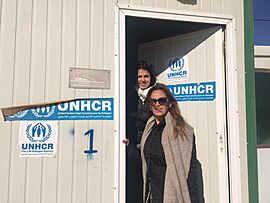
The UN also plays a big role in coordinating emergency aid. The World Food Programme (WFP) provides food aid during famines and disasters. It feeds millions of people each year. The Office of the United Nations High Commissioner for Refugees (UNHCR) protects refugees. These programs get money from countries, companies, and individuals.
Environment and Climate
The UN started focusing on environmental issues in 1972 with the UN Environmental Programme (UNEP). In 1992, the Earth Summit in Brazil tried to boost these efforts. In 1988, UNEP and the World Meteorological Organization (WMO) created the Intergovernmental Panel on Climate Change. This group studies and reports on global warming. The UN also sponsored the Kyoto Protocol, a treaty to reduce harmful emissions.
Other Global Issues
Since the UN was created, over 80 colonies have become independent. The UN works to help territories gain self-governance. The UN also sets up special international days to raise awareness about important global issues. Examples include Earth Day.
Since 2023, the UN Office for Digital and Emerging Technologies has held a UN Open Source Week. This event helps with international tech projects and AI policies.
How the UN is Funded
| Member state | Contribution (% of UN budget) |
|---|---|
|
22.000
|
|
|
15.254
|
|
|
8.033
|
|
|
6.111
|
|
|
4.375
|
|
|
4.318
|
|
|
3.189
|
|
|
2.628
|
|
|
2.574
|
|
|
2.134
|
|
|
2.111
|
|
|
2.013
|
|
|
1.866
|
|
|
1.377
|
|
|
1.221
|
|
|
1.184
|
|
|
1.134
|
|
|
1.044
|
|
|
0.871
|
|
|
0.845
|
|
|
0.837
|
|
|
0.828
|
|
|
0.719
|
|
|
0.679
|
|
|
0.679
|
|
| Other member states |
11.976
|
The UN's budget for 2024 was $3.59 billion. This does not include extra money given by members for things like peacekeeping. When you add all the UN groups together, their total spending was $67.4 billion in 2022.
The UN gets its money from member countries. The General Assembly decides how much each country should pay. This amount is based on how much money each country makes. There is a limit to how much any one country has to pay for the regular budget, which is 22%. For the poorest countries, the minimum is 0.01%.
A big part of the UN's spending goes to peacekeeping. This budget is separate. For 2021–2022, the peacekeeping budget was $6.38 billion. The five permanent Security Council members pay more for peacekeeping. This helps less developed countries pay less. The biggest contributors to the peacekeeping budget for 2023–2024 include the United States, China, and Japan.
Special UN programs like UNICEF and the World Food Programme get money from voluntary donations. These come from governments, companies, and individuals.
How the UN is Seen
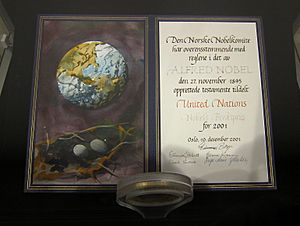
Many studies have looked at how well the UN Security Council responds to conflicts. They found that the Council is more likely to meet about intense conflicts that cause a lot of suffering. However, the political interests of member countries, especially the permanent ones, also play a role.
UN peacekeeping missions are generally seen as successful. A study of 47 peace operations found that UN-led efforts often lead to long-lasting peace. Researchers also found that UN peacekeeping is better at reducing civilian deaths than other military actions.
Experts believe UN peacekeeping works well because it focuses on talking, offering help, and using non-military ways to get warring groups to change their behavior.
Historian Paul Kennedy says that even with its problems, the UN has brought great benefits to people today and will continue to do so for future generations.
In 2012, French President François Hollande said that France trusts the UN. He believed no single country, no matter how powerful, can solve all global problems alone. American President Dwight D. Eisenhower also said that the UN is humanity's best hope for solving problems through discussion instead of war.
Professor Jacques Fomerand notes that the UN's achievements over 60 years are impressive. He says that progress in human development has been huge, and the UN has helped make the world a better place for millions.
Looking back at the UN's first 50 years, author Stanley Meisler wrote that the UN did not meet all its founders' hopes, but it still achieved a lot. He pointed to its role in helping colonies become independent and its many successful peacekeeping efforts.
Awards and Recognition
Many UN groups and people connected to the UN have won the Nobel Peace Prize. Two Secretaries-General, Dag Hammarskjöld and Kofi Annan, each won the prize. Other winners include Ralph Bunche, a UN negotiator, and Eleanor Roosevelt, who helped write the Universal Declaration of Human Rights. Lester B. Pearson won for organizing the first UN peacekeeping force during the Suez Crisis.
UNICEF won the prize in 1965. The International Labour Organization won in 1969. UN Peacekeeping Forces won in 1988. The International Atomic Energy Agency won in 2005. The UN-supported Organisation for the Prohibition of Chemical Weapons won in 2013. The UN High Commissioner for Refugees won twice, in 1954 and 1981. The UN as a whole shared the prize with Kofi Annan in 2001. In 2007, the Intergovernmental Panel on Climate Change (IPCC) received the prize for its work on climate change.
On March 21, 2025, the Universities of Leuven and Louvain in Belgium gave the UN an honorary degree. António Guterres accepted it.
Model United Nations
The United Nations has inspired a popular school activity called Model United Nations (MUN). In MUN, students pretend to be delegates from different countries. They hold conferences to discuss important world issues, just like the real UN. MUN helps tens of thousands of students around the world learn about the UN's work. Many famous people, including former UN Secretary-General Ban Ki-moon, participated in MUN when they were students.
Hymn to the United Nations
In 1971, then-Secretary-General U Thant asked Pau Casals to create a "Hymn to the United Nations." The words for the song were written by the poet W. H. Auden.
Thant wanted a song about peace, based on the UN Charter's introduction. Casals asked Auden to write a poem for the music. Auden finished it in three days. The song, for a choir and orchestra, is about seven minutes long. However, it was never planned to be the UN's official anthem.
See also
 In Spanish: Organización de las Naciones Unidas para niños
In Spanish: Organización de las Naciones Unidas para niños
- International relations
- List of country groupings
- List of current permanent representatives to the United Nations
- List of multilateral free-trade agreements
- PassBlue
- Spying on the United Nations
- UNICEF
- United Nations Convention Against Torture
- United Nations in popular culture
- United Nations Memorial Cemetery
- United Nations television film series
- World Summit on the Information Society




